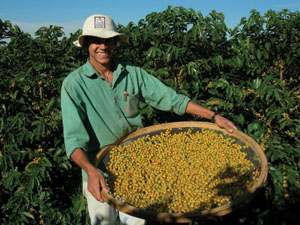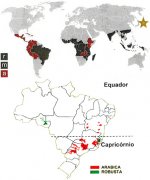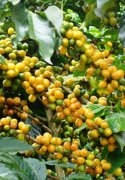Brazilian coffee commercial beans VS boutique beans: lack of personality beauty but not without boutique

Professional barista communication, please pay attention to coffee workshop (Weixin Official Accounts cafe_style)
Brazil, known as the "Coffee Kingdom", once accounted for 60% of the world's total coffee production at the beginning of the 20th century, and currently produces an average of more than 30 million bags (60 kg per bag) annually, accounting for 30% of the world's production. Although Brazil is the largest producer of coffee, Brazilian coffee plantations are low in altitude, the production environment is not covered by trees, and the machine is harvested, and the evaluation of sunlight exposure in the coffee industry is not high, and does not meet the conditions of fine coffee. But that doesn't mean there isn't fine coffee in Brazil. Arabica bourbon and cirado are examples.
Coffee was introduced into Brazil in 1727, which is located in the tropics and subtropics. The unique geographical and climatic conditions are suitable for coffee cultivation. In addition, the labor force is cheap. Coffee cultivation has rapidly emerged and become the economic pillar of Brazil, bringing wealth and prosperity to Brazil. In the early days, there were as many as 50 coffee plantations of various sizes in Brazil, with a planting area of about 2.2 million hectares, a population of more than 6 million, an annual output of about 2 million tons of coffee and an annual export of nearly 2 billion US dollars. Brazil's coffee production and exports have declined in recent years due to changes in export structure and the downturn in the international coffee market.
Not sour, not fragrant, not bitter, lacking personality beauty
Brazilian coffee does not have a good image in the market, mainly due to the violation of the necessary shade cultivation and mechanical harvesting of coffee, in addition, most Brazilian coffee farmers use the labor-saving sun treatment method. However, there are reasons why Brazilian coffee is still naturally dried. First, because of the weather, there is not enough water in the production area to handle the refining process of coffee beans in large quantities. Second, because Brazil has a large flat terrain, it is suitable for large-scale production by natural drying. But also often due to climate humidity and other variables, causing coffee beans moldy, and produce a rotten smell.
Coffee connoisseurs do not rate Brazilian beans highly, believing that Brazilian coffee is too monotonous, neither sour nor bitter, lacking in personality beauty, and even does not include Brazil in the list of fine coffee producing areas. For many years brazilian coffee farmers struggled to increase production and market share at the expense of quality. However, interestingly, the lack of personality of Brazilian coffee beans still dominate the coffee market, occurred in 1975 and 1994 respectively in Brazil coffee garden frost disaster, Brazilian coffee beans failed to harvest, has caused global coffee prices skyrocketing.
Brazilian coffee is cheap, but it has become a cheap choice for beginners to taste coffee; on the other hand, if you want to make an elegant and affordable blend of coffee, Brazilian coffee is the best foil choice, such as the well-known Mamba coffee, Moba coffee…etc. In addition, Rio coffee on the coast even has iodine and salty taste, which is believed to be the result of some microbial action, but even if the same soil is used to grow, it does not necessarily produce this flavor every year. Although most coffee lovers do not appreciate this flavor, a few Middle Eastern countries have the habit of sugar and brewing coffee, which is particularly suitable for this Rio coffee flavor.
Brazilian coffee beans are not without quality
In fact, not all coffee produced in Brazil is cheap and cannot be included in the list of fine coffee, generally known as Brazilian coffee beans, roughly referred to as Santos (Santos). There is a very good variety of Brazilian beans, but the yield is very small, this kind of coffee bean is called Bourbon strain of Coffee Arabica (Arabica Bourbon), it is the coffee bean that grows out of the early stage of coffee planting, the bean shape is small and round, the taste is very good, it contains fine acidity and sweetness; but after several harvests, the coffee bean will become larger and lose some flavor, this time the coffee is called flat bean Santos (flat bean Santos).
Another variety is also quite well-known coffee called Cerrado(Arabica Bourbon), which is generally planted at an altitude of about 1100 meters, with an average temperature of only 20 ° C throughout the year. The soil layer belongs to the gravel layer, similar to the soil of French grape estates, which is conducive to drainage and nutrient retention. Due to the clear dry and wet seasons and the comfortable low temperature, the flavor is quite different from the well-known Brazilian coffee bean flavor.
Important Notice :
前街咖啡 FrontStreet Coffee has moved to new addredd:
FrontStreet Coffee Address: 315,Donghua East Road,GuangZhou
Tel:020 38364473
- Prev

Brazilian Coffee Fine Coffee Bean treatment introduces how to make and drink Brazilian coffee
The exchange of professional baristas please follow the coffee workshop (Wechat official account cafe_style) about coffee production. The main consideration is ① production, ② diseases and insect pests, ③ quality, in terms of agricultural stability, the first priority is production. In addition, 80% of Brazilian coffee is dried, and the remaining 20% is semi-dried and washed. Its coffee taste characteristics are different, but high.
- Next

Brazil Coffee Manor-South Minas producing area COE third Runner-up Shenmu Manor Yellow bourbon Coffee introduction
For professional baristas, please follow the coffee workshop (official Wechat account cafe_style) producing area / South Minas varieties / Yellow bourbon Yellow Bourbon treatment / Solar planting altitude / 1200 m Shenmu Manor is located in the mountainous area of South Minas, its elevation is about 1200 meters, the average annual temperature is about 19 degrees and the rainfall is about 1600 mm. Minas is the heaviest in Brazil.
Related
- Detailed explanation of Jadeite planting Land in Panamanian Jadeite Manor introduction to the grading system of Jadeite competitive bidding, Red bid, Green bid and Rose Summer
- Story of Coffee planting in Brenka region of Costa Rica Stonehenge Manor anaerobic heavy honey treatment of flavor mouth
- What's on the barrel of Blue Mountain Coffee beans?
- Can American coffee also pull flowers? How to use hot American style to pull out a good-looking pattern?
- Can you make a cold extract with coffee beans? What is the right proportion for cold-extracted coffee formula?
- Indonesian PWN Gold Mandrine Coffee Origin Features Flavor How to Chong? Mandolin coffee is American.
- A brief introduction to the flavor characteristics of Brazilian yellow bourbon coffee beans
- What is the effect of different water quality on the flavor of cold-extracted coffee? What kind of water is best for brewing coffee?
- Why do you think of Rose Summer whenever you mention Panamanian coffee?
- Introduction to the characteristics of authentic blue mountain coffee bean producing areas? What is the CIB Coffee Authority in Jamaica?

